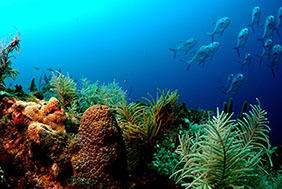Featured Archive - 2021 Publications
Below is a sampling of publications generated by NOAA's coral ecosystem activities in 2021. To access a complete list of NOAA coral ecosystem related publications, use the CoRIS Geoportal
(https://www.coris.noaa.gov/search/) search tool.
NOAA and their partners developed the first ever guidance manual aimed at reducing erosion and sediment delivery from unpaved roads in Pacific and Caribbean island jurisdictions. This guidance document helps users identify the cause of unpaved road erosion; develop a strategy for addressing the problem; and implement that strategy on a specific road, or on a larger, ecologically-meaningful scale (i.e., watershed or municipality).
The National Coral Reef Monitoring Program released an updated NCRMP plan for 2021 that reflects advances in technology, science, and approach, and continues to stress the program's strong commitment to collaboration among the participating NOAA line offices, programs, and labs.
The National Coral Reef Monitoring Program released a new report on biological monitoring data, including benthic and fish data, from the U.S. Virgin Islands and Puerto Rico. The report summarizes the status of coral reef biological data in the region from the most recent data collection in 2019, and is also the first Atlantic biological report to show trends from sampling every two years since 2013.
As threats to coral reefs-ocean warming, ocean acidification, fishing pressure, and local impacts like pollution-increase in severity and frequency, scientists are looking for ways to increase monitoring scale and efficiency. Scientists are now exploring the use of 3D technology such as photogrammetry, also called Structure-from-Motion, to collect imagery that can be analyzed later and significantly reduce dive time underwater. Collecting 3D imagery also has the added benefit of creating a permanent record of a reef site to look at in the future. While Structure-from-Motion imagery can potentially save time in the water, it involves much more time to extract data. The big question is whether data collected in the water in real-time is comparable to data extracted from 3D imagery for the same reef area. In a new study, National Coral Reef Monitoring Program scientists at the Pacific Islands Fisheries Science Center led by Dr. Courtney Couch compared data from in-water coral surveys to data generated from Structure-from-Motion imagery for the first time to test the differences between the methods for the same reef areas.
Coral reefs provide important economic and environmental services (also known as ecosystem services) such as food, protection for coasts, recreation and tourism. With all of these services and benefits that coral reefs support, a couple of questions to consider are how much are coral reefs worth and how much do coral reefs impact the economy? In 2016-2017, NOAA's Coral Reef Conservation Program funded two studies to assess the economic impacts to county and state-level Florida economies generated from 1) recreational fishing trips and 2) SCUBA diving and snorkeling trips on Southeast Florida's reefs. The economic impacts of reef-related recreational fishing, diving and snorkeling were estimated and are reported in two reports. The reports include estimates for the Southeast Florida counties of Martin, Palm Beach, Broward, Miami-Dade, Monroe and the state of Florida.
NOAA's Atlantic Oceanographic and Meteorological Laboratory used climate monitoring data and coral cores from the National Coral Reef Monitoring Program to show that two key coral species in Flower Garden Banks have increased calcification in the past 45 to 57 years. The data indicate that these corals have actually benefited from warming ocean temperatures over the last few decades. However, based on climate projections and the warming trend, the stimulation in growth due to warmer waters will eventually be impacted by worse and more frequent coral bleaching events. Given that the most severe bleaching event ever recorded at Flower Garden Banks occurred in 2016, the growth rates of these corals are likely reaching the threshold where further increases in ocean temperatures will no longer benefit coral growth.
The Socioeconomic Component of the National Coral Reef Monitoring Program (NCRMP) gathers and monitors a collection of socioeconomic data in seven U.S. coral jurisdictions. The team started its second monitoring cycle with data collection in South Florida in 2019, and recently released their report of summary findings along with a new infographic. The report outlines current human dimensions information relevant to coral reef resources in South Florida, as well as trends between the first (2014) and second monitoring cycles, while the infographic focuses solely on the 2019 findings. Survey results are representative of each of the five counties adjacent to Florida's coral reef tract: Martin, Palm Beach, Broward, Miami-Dade, and Monroe.


